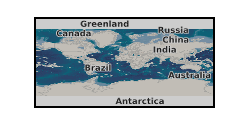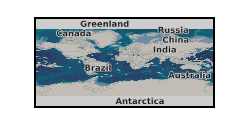Radar
Type of resources
Available actions
Topics
Keywords
Contact for the resource
Provided by
Years
Formats
Representation types
Update frequencies
-
HYREX (Hydrological Radar Experiment) was a NERC (Natural Environment Research Council) special topic running from May 1993 to April 1997. Field experiments with an emphasis on radar, plus related interpretation and modelling, were carried out to investigate the short term forecasting and hydrological implications of precipitation. A special purpose-built dense rainguage network was established in Somerset as part of the project. Rainguage, radar and related meteorological data plus forecast data from the Met Office Unified Model are available through BADC.
-
Data from the Upper Troposphere Lower Stratosphere (UTLS) programme's round 1 research project "Dynamics and Chemistry of Frontal Zones" (DCFZ). DCFZ investigated the role of frontal shear zones in determining upper tropospheric chemical distributions. This dataset contains Chilbolton radar images.
-
The UK's Natural Environment Research Council's (NERC) National Centre for Atmospheric Sciences (NCAS) operates a suite of instrumentation to monitor the atmospheric dynamics and composition of the atmosphere. This dataset brings together all the long term routine observations made by NCAS instruments covering surface based instruments as well as remote sensing instruments such as radars and lidars. Some of the instruments may also be deployed elsewhere on field campaigns, for which the data will be available under the associated field campaign dataset. Links are also available to pages describing the instruments from which links to all data from that particular instrument can be found.
-
The Hydrological Radar Experiment (HYREX) was a UK Natural Environment Research Council (NERC) Special Topic which ran from May 1993 to April 1997. The broad aim of HYREX was to gain a better understanding of rainfall variability, as sensed by weather radar, and how this variability impacts on river flow at the catchment scale. Six projects were funded involving groups from CEH Wallingford (formerly the Institute of Hydrology), the Rutherford Appleton Laboratory and the universities of London (Imperial College and University College), Newcastle, Reading (including the Joint Centre for Mesoscale Meteorology or JCMM) and Salford. The projects ranged from research on improved precipitation measurement using polarisation and vertical pointing radars, through network design of radar/raingauge networks and spatial-temporal modelling of rainfall fields, to rainfall forecasting based on stochastic and meteorological concepts. An overview of the six HYREX projects and a list of the members of the HYREX Steering Committee are available as separate documents. The experiment was centred on the Brue catchment in Southwest England. The common experimental infrastructure comprised two national network C-band radars at Wardon Hill (Doppler) and Cobbacombe Cross, a purpose-built dense raingauge network, an automatic weather station (AWS), an automatic soil water station (ASWS), and a river gauging station. These instruments have provided a continuous record throughout HYREX. Further instrumentation, deployed on an occasional basis, included an experimental S-band Doppler dual polarisation radar at Chilbolton and an associated line network of rapid-response raingauges (operated by Rutherford Appleton Laboratory), a transportable vertically pointing X- band radar (operated by the University of Salford), the UK Meteorological Office (UKMO) Research Flight and radiosonde network, and a disdrometer (operated by CEH Wallingford). The JCMM provided output from special runs of the UKMO Unified Model (UM). Infrastructure support was provided by the UKMO, the Environment Agency (EA), NERC, Rutherford Appleton Laboratory, the Ministry of Agriculture, Fisheries and Food (MAFF) and the water utilities. The occasional deployment of some instruments was scheduled to coincide with a number of one or two day Intense Observing Periods (IOPs), triggered by meteorologically interesting conditions, during which radiosonde ascents and aircraft overflights were made, and for which special runs of the Unified Model were made.
-
The Bolton Experiment was an experimental test of the use of microwave attenuation to improve rainfall estimates in urban areas, and hence to enhance flood warning. Data was collected from microwave and radar links and a number of telemetered tipping bucket raingauges. The dataset contains microwave, raingauge and radar data. It also contains data analysis to extract information from the link attenuation data on path-averaged rainfall rate, and comparison with the results with those obtained from the raingauges and the radar. The dataset is now public.
-
The Exploitation of new data sources, data assimilation and ensemble techniques for storm and flood forecasting Project is a NERC Flood Risk for Extreme Events (FREE) Research Programme project (Round 1 - NE/E002137/1 - Duration January 2007 - April 2010) led by Prof AJ Illingworth, University of Reading. This project investigates possible methods of producing ensemble weather forecasts at high-resolution. These ensembles will be used with raingauge and river flow to improve methods of flood forecasting. The dataset includes radiosonde and wind profiles in England and Wales derived using Doppler radar returns from insects. The radial velocity measurements from insects were converted into VAD profiles by fitting a sinusoid to radial velocities at constant range. All measured profiles have been interpolated to the instrument location. This dataset contains UK Met Office model equivalent of radiosonde, radar and wind profiles.
-
The MICROwave investigation of MIXed phase cloud (MICROMIX) project was a Facility for Airborne Atmospheric Measurements (FAAM) Campaign from late 2005, beginning of 2006, which aimed at testing and improving the representation of mixed phase clouds in radiative transfer models. The intention was to fly the FAAM BAE-146 aircraft in conjunction with the Chilbolton radar facility and ASMU overpasses in order to characterise the in-situ microphysics, spatial variability of the microphysics and the radiative properties respectively.
-
The survey collected a total of 11,500 km of data along 22 lines, spaced 12 km apart and oriented perpendicular to the strike of both the Bouguer anomaly field, as derived from land data (McGibbon and Smith, 1991), and the major sub-ice topographical features (Doake et al., 1983). The speed of the aircraft was set to produce a sample spacing of about 60 m and the data were collected at heights between 1600 and 2000 m above sea level. The gravity signal was recorded using a LaCoste and Romberg air/sea gravimeter, S-83, which has been kindly loaned to BAS by the Hydrographic Office of the Royal Navy. The meter was modified by the ZLS company for use in an aircraft. The equipment was deployed in a BAS De-Havilland Twin Otter aircraft. Differential, dual frequency, carrier phase, GPS measurements of the aircraft''s motion were made using Trimble and Ashtech geodetic receivers and antennas. Ice thickness data were obtained using a BAS-built, radio echo sounding system (Corr and Popple, 1994). Ice-bottom returns over most of the survey area were obtained at a sample spacing of approximately 28 m. GPS measurements were tied into base stations in International Terrain Reference Frame network (Dietrich et al., 1998) and gravity measurements to base stations in the IGSN71 net (Jones and Ferris, 1999). We present here the processed bed elevation picks from airborne radar depth sounding collected using the BAS PASIN radar system. Data are provided as XYZ ASCII line data.
-

Surface level measurements of the Erebus volcano lava lake, Antarctica. Surface level was measured from a site at the crater rim using the Eredar radar system, a ground-based X-band FMCW radar (described in detail here: https://doi.org/10.1029/2018GL079177). The dataset contains a single continuous measurement period from 2016 (all times in UTC): 19 Dec 00:35 -> 19 Dec 19:21 Measurements were taken at a rate of ~0.25 Hz, using a 0.16 s 400 MHz bandwidth Linear Frequency Modulated chirp centred at 10.4 GHz, with 10 chirps being averaged for each measurement.
-

Surface level measurements of the Halema'uma'u lava lake, Hawaii. Surface level was measured from a site at the crater rim (19.40452 N 155.27944 W 1125 M a.s.l) using the Eredar radar system, a ground-based X-band FMCW radar (described in detail here: https://doi.org/10.1029/2018GL079177). Due to technical problems, the radar did not acquire continuously throughout its deployment. The dataset contains three blocks of successful continuous measurement periods (all times in UTC): 10 Jan 22:18 -> 11 Jan 08:46 11 Jan 21:24 -> 12 Jan 22:49 14 Jan 20:27 -> 14 Jan 23:01 Measurements were taken at a rate of ~1 Hz, using a 20 ms 400 MHz bandwidth Linear Frequency Modulated chirp centred at 10.25 GHz.
 NERC Data Catalogue Service
NERC Data Catalogue Service